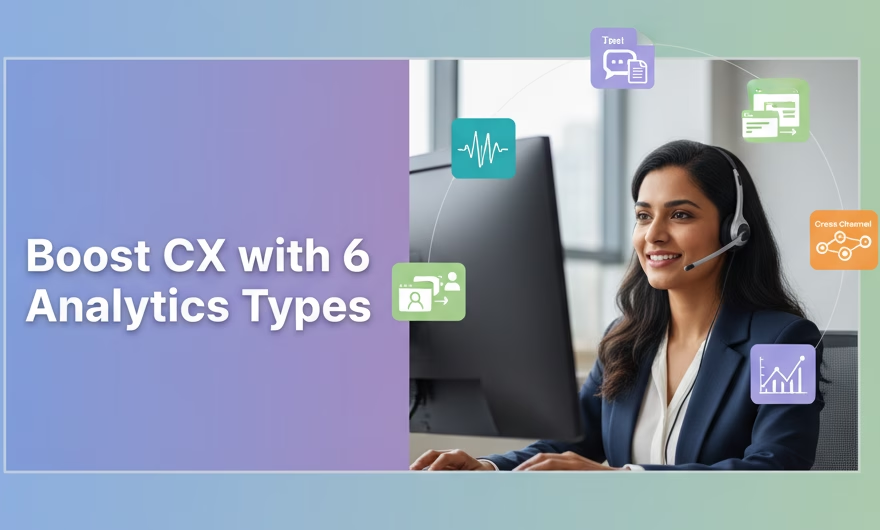Call center analytics have evolved significantly, becoming essential for assessing and refining customer relationship management strategies. The goal is to drive quick, responsive, and consistent experiences across every interaction. The six core types of call center analytics below help teams study customer interactions, recognize patterns, identify knowledge gaps, and fix issues through training, process improvements, or technology enhancements—ultimately elevating both customer experience and operational efficiency.
Different Kinds of Call Center Analytics
1. Speech Analytics
Speech analytics focuses on voice conversations—transcribing calls and analyzing what is said and how it’s said. Modern solutions use speech-to-text, natural language understanding, and acoustic cues to detect topics, intent, sentiment, emotion, silence, and overtalk. They can operate post-call for deep analysis or in real time to guide agents during live conversations.
- What it helps you discover: recurring product issues, policy confusion, process bottlenecks, competitive mentions, compliance risks, and drivers of churn or dissatisfaction.
- How it helps agents and teams: real-time prompts for empathy and disclosures, automatic call summaries, auto-QA scoring, and targeted coaching based on objective call insights.
- Common KPIs impacted: first contact resolution (FCR), customer satisfaction (CSAT), average handle time (AHT), and compliance scores.
- Good practices: tune vocabularies for domain terms, support multiple languages and accents, and integrate findings with quality management and training workflows.
2. Text Analytics
Text analytics examines written interactions such as email, chat, messaging apps, social media, and support tickets. By extracting intents, topics, and sentiment from text, it surfaces the themes driving contacts and the friction points customers encounter outside of voice channels.
- What it helps you discover: trending issues in chat and email, emerging topics from social posts, and gaps in knowledge base content that trigger escalations.
- How it helps agents and teams: faster triage and routing, prioritization of urgent or negative-sentiment messages, and improved knowledge articles based on real customer language.
- Common KPIs impacted: response time, resolution time, containment/deflection rate, and sentiment trends across digital channels.
- Good practices: combine text and speech insights for a unified view, account for multilingual variations and abbreviations, and maintain privacy by redacting sensitive data.
3. Desktop Analytics
Desktop analytics monitors agent interactions with applications and systems during and after calls. Rather than focusing on surveillance, the goal is to understand workflow friction and guide agents to complete tasks accurately and efficiently.
- What it helps you discover: excessive toggling between systems, duplicate data entry, long after-call work, and steps that commonly lead to errors.
- How it helps agents and teams: step-by-step guidance, next best action suggestions, and automation triggers that reduce manual effort and improve accuracy.
- Common KPIs impacted: AHT, wrap time, error rate, schedule adherence, and productivity.
- Good practices: use event-level telemetry instead of intrusive keystroke tracking, focus on process improvement over policing, and ensure transparency and consent to build trust.
4. Cross-Channel Analytics
Cross-channel (often called omnichannel) analytics connects customer journeys across voice, chat, email, social media, messaging apps, and the web. It reveals how and why customers switch channels, where journeys stall, and which paths lead to quick resolutions.
- What it helps you discover: common channel-hopping patterns (e.g., web to chat to voice), the reasons behind repeat contacts, and the interactions that most influence satisfaction.
- How it helps agents and teams: consistent context follows the customer, smarter routing, better staffing across channels, and coordinated outreach to prevent unnecessary repeat interactions.
- Common KPIs impacted: channel containment, repeat contact rate, journey effort, and overall CSAT/NPS for end-to-end experiences.
- Good practices: apply identity resolution to unify profiles, standardize taxonomies for topics and intents across channels, and use A/B testing to optimize channel prompts and handoffs.
5. Self-Service Interactions
Self-service analytics evaluates customer experiences in IVR, interactive virtual agents (IVAs), chatbots, and knowledge bases. Done well, it reduces customer effort while keeping escalation pathways seamless when human help is needed.
- What it helps you discover: intents not recognized by bots, steps with high abandonment, authentication pain points, and knowledge articles that fail to resolve issues.
- How it helps agents and teams: improved dialog design, clearer self-service menus, better search and article relevance, and smoother escalations with full context passed to agents.
- Common KPIs impacted: self-service containment and task completion, abandonment rate, authentication success rate, and escalation quality (e.g., fewer transfers, faster resolutions).
- Good practices: iterate with journey and drop-off analytics, design for accessibility and multilingual use, and ensure sensitive data is handled securely in automated flows.
6. Predictive Analytics
Predictive analytics uses historical and real-time data to anticipate needs and recommend next best actions. It informs everything from forecasting and workforce planning to proactive customer outreach and personalized service or sales offers.
- What it helps you discover: the likelihood of contact reasons by time or segment, customers at risk of churn, propensity to buy, and the best channel or time to connect.
- How it helps agents and teams: dynamic knowledge suggestions, intelligent callbacks with accurate wait-time estimates, prioritized queues for high-value or high-risk cases, and early alerts for anomalies.
- Common KPIs impacted: service level and SLA adherence, AHT, conversion and upsell rates, retention, and cost-to-serve.
- Good practices: combine predictive models with business rules for control, monitor models for drift and fairness, and document decision logic for compliance and auditability.
Bringing the Six Analytics Types Together
Each analytics type delivers value on its own, but the strongest gains come from connecting them. For example, speech and text analytics can jointly identify a surge in complaints, cross-channel analytics can reveal where the journey fails, desktop analytics can show the exact workflow friction agents face, self-service analytics can fix the knowledge gap upstream, and predictive analytics can forecast and prevent the spike from recurring.
- Unify data and definitions: standardize intents, reasons for contact, and outcome codes across channels to ensure apples-to-apples comparisons.
- Close the loop: feed insights into quality management, coaching, process changes, and knowledge updates—then measure impact on KPIs.
- Balance real-time and post-call: use real-time analytics to assist agents and deflect issues in the moment, while post-call analytics drives structural improvements.
- Embed governance: protect sensitive data with redaction and role-based access, and maintain transparent policies for analytics and monitoring.
What to Prioritize First
Focus on a small set of measurable outcomes, then expand:
- Reduce repeat contacts: combine speech/text analytics with journey mapping to find root causes, then update processes or knowledge content.
- Lower AHT without hurting CSAT: use desktop analytics to streamline steps and predictive suggestions to surface the right guidance at the right time.
- Strengthen containment: iterate bot and IVR flows with self-service analytics, while preserving smooth escalations with full context for agents.
- Improve compliance: leverage speech and desktop analytics for disclosures and secure handling of sensitive data, with clear audit trails.
Conclusion
Speech, text, desktop, cross-channel, self-service, and predictive analytics together form the foundation of a modern, insight-driven contact center. By using these six types in tandem—aligning them to specific business outcomes, connecting data across channels, and embedding governance—you can resolve customer issues faster, coach agents more effectively, and continuously improve journeys. Start with the highest-impact use cases, measure rigorously, and build on what works to transform customer experience and operations at scale.




